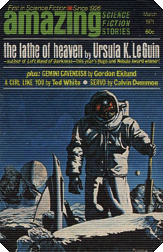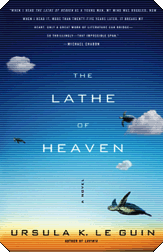The Lathe of Heaven
by Ursula K. Le Guin
Reviewed by Galen Strickland
Posted January 31, 2023
Buy from Bookshop or Amazon. A purchase through our links may earn us a commission.
The Lathe of Heaven was the first of Le Guin's standalone novels, not connected to either of her previously established series, the Hainish stories or Earthsea. It's a mix of science fiction and fantasy, but might best be described as psychological horror. It was originally serialized in two parts in the March and May 1971 issues of Amazing Science Fiction Stories, then published in hardcover (pictured to the right) in October of that year. I am sure that was the cover on the first copy I read, and most likely from the Science Fiction Book Club. As I grow older it is hard for me to remember when I first read a book, and while I'm sure I had read others by Le Guin before it, I don't know if I read Lathe before or after I saw the television adaptation on PBS in 1980. I recently rewatched that, and while I like it, it doesn't carry the same weight as the book, and misses a lot of the underlying psychology of the main character, George Orr.
If this had been a short story it would have been ideal to have been adapted as a Twilight Zone episode, but that would have had to be even more streamlined. So, imagine if you will, in Portland, Oregon, in the near future (at the time of the writing) of 2002, a man is tormented by the notion that his dreams can alter reality, and in doing so no one else is aware of it, accepting the new world as they believe it has always been. George Orr takes a variety of drugs to either keep himself awake, or when sleep is inevitable, he turns to barbituates that will knock him out so much that his brain can't rise to the dream state. Since he borrows drug cards from friends and co-workers, his situation comes to the attention of HEW, the Department of Health Education and Welfare, the precursor to Health and Human Services. He is remanded to Voluntary Therapy, assigned to Dr. William Haber, an oneirologist, a dream specialist. In the beginning of their sessions, Dr. Haber thinks George is afraid of dreaming due to traumas he doesn't want to deal with. If he only knew. Later, George is convinced that Haber, being in close proximity to him while he dreams, is aware of the changes the dreams make, but keeps that information to himself.
That's the setup, followed by a frequent trope in SF, that of a person who becomes aware of a way to change the world, declaring himself to be the ideal person to be able to use that power to make the best changes. Unfortunately, when Haber suggests a dream for George, the results are uncontrollable and unexpected. Haber might be able to advance his own position, such as becoming the head of a new Oneirology Institute, others don't fare as well. Told to dream of a less crowded world, George's psyche produces a plague that wipes out the majority of the world's population. Told to dream of peace, to stop nations warring against each other, George's dream creates an alien race that lands on the moon, with all nations on Earth turning their weapons away from each other and toward the alien menace. Previously, George had presented his case to an HEW attorney, for her to observe one of his dream sessions. She experiences the shift in reality at the same time as George and Haber. Later, she is able to put George into a hypnotic/dream state, suggesting he dream the aliens off the moon. They wake to the aliens invading Earth. If only Haber had been aware of the core trauma that George had witnessed, the one that convinced him of his ability, he would have approached their therapy sessions differently. George's dreams would always be chaotic due to that trauma.
In addition to the "mad scientist" trope, a deeper level of meaning is of how modern man feels trapped in his own head, unable to connect to others emotionally or intellectually. The trauma that George had witnessed, that everyone else seems unaware of, was the result of the ultimate misunderstanding of all time. Since George is the only one aware of that alternate reality, he is truly lost in a world of his own. That is, until he meets that HEW lawyer, Heather Lelache, who is able to see through his shell, to make the necessary connection to give George a new reason to continue with life. The "shell" metaphor is mirrored by the aliens, whom George thinks resemble giant tortoises. Without Heather, George may have eventually taken his own life, but he was stronger than that, knew what that would mean for everyone else. He was even stronger than Haber, who taking the dream power as his own, faces that terrible truth. And it breaks him.
As I said above, the first I read had the same cover as the original hardcover. Below are some other images, starting with the March '71 Amazing cover. I replaced my original copy with an omnibus, the second image below, which I got from the Quality Paperback Book Club. That also replaced an earlier paperback of The Dispossessed, and got me my first copy of the story collection The Winds Twelve Quarters. The third image is the currently available paperback, for which I've provided purchase links at the top of the page. I recommend this book highly, as I do for almost everything else I've read by Le Guin. It is full of intellectual and emotional insight about how we should shape our own lives, how to interact with others for mutual benefit, and warns about the pitfalls of selfish behavior.



We would appreciate your support for this site with your purchases from Amazon.com, Bookshop.org, and ReAnimusPress.